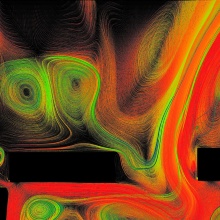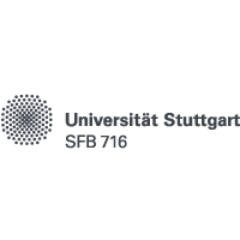Simulations are omnipresent today in science and technology. Be it biosciences, medicine, mechanical engineering, physics, chemistry or material research – scientific progress is scarcely conceivable today for a large section of research fields without computer simulation. They complement theories and experiments in the laboratory, enable findings in fields that would otherwise have been denied to us and grant us a look into the future. Simulation research is a significant focal research point at the University of Stuttgart.
Going by the motto “Understanding the world through computer simulations”, the Science Exhibition “In the Digital Laboratory” gives a diverse range of insights into the world of computer simulations from 9th May until 30th July in the Planetarium Stuttgart. It will highlight its development, its methods and operating principles and show in a generally comprehensible way vivid application examples from various research fields.
The simulation will show scenarios from future applications being designed or models developed that simplify the understanding of the processes in nature and technology. Whether on the level of atoms and molecules or the infinite expanse of our space – computer simulations can be used for (almost) everything. Even our everyday life is full of things for whose development a simulation was made – from the microchip in the mobile phone to the car up to common medicines and forms of therapy. There are numerous reasons to simulate a process on the computer: experiments are often far too dangerous, too expensive, hard to conduct or even not ethically justifiable.
Yet how to simulations occur? How have they developed over the course of time? What do we need for this? And what do we use them for? The Science Exhibition “In the Digital Laboratory – understanding the world through computer simulations” gets to the bottom of this as well as other questions. Digital and analogous interactions invite us to playfully discover the topic of all aspects of computer simulations.
In the supporting program of the exhibition lectures by scientists open up the possibility to find out in detail about various research fields that work with computer simulations – for example on the topics of energy storage, crash tests or astronomy.
The fair was developed by two large research associations from the University of Stuttgart that deal with computer simulations: the Excellence Cluster Simulation Technology (SimTech) and the Collaborative Research Center “Dynamic Simulation of Systems with large particle numbers“ (SFB 716). Both are funded by the German Research Foundation (DFG).
Basic Information:
Period: 9th May until 30th July 2017
Venue: Carl-Zeiss-Planetarium Stuttgart (central castle garden), Spectral Hall, Willy-Brandt-Straße 25, 70173 Stuttgart
Entrance to the exhibition and series of lectures is free.
The exhibition is accessible during the opening hours of the Planetarium.
Supporting Program:
Series of Lectures:
Room: Planetarium Stuttgart, Kepler Hall
- Wednesday, 17th May 2017, 6.30 pm
Professor Dr.-Ing. Rainer Helmig, Institute for Water and Environmental Modelling, University of Stuttgart:“Energy storage, challenge of the future. What simulations contribute“
- Wednesday, 24th May 2017, 30 pm
Professor Dr. rer. nat. Christian Holm, Institute for Computer Physics, University of Stuttgart: “Simulating physics with particles in an entirely classic way“
- Wednesday, 31st May 2017, 30 pm
Young Professor Dr.-Ing. Jörg Fehr, Institute for Technical and Numeric Mechanics, University of Stuttgart: “Crash tests on the computer“
- Wednesday, 21st June 2017, 30 pm
Young Professor Dr. rer. nat. Syn Schmitt, Institute for Sport and Kinesiology and Professor Oliver Röhrle, Institute for Mechanics (Building Industry), University of Stuttgart:“Simulating humans on the computer. How simulations learn to walk“
- Wednesday, 12th July 2017, 30 pm
Professor Dr. rer. nat. Daniel Weiskopf, Visualisation Institute, University of Stuttgart: “3D-Visualisation planetary nebulae“
- Wednesday, 26th July 2017, 30 pm
Professor Dr.-Ing. Michael Resch, High Performance Computing Centre (HLRS), University of Stuttgart: “On the scientific theory of simulation. Which role simulations play for society"
Initiators:
Excellence Cluster Simulation Technology (SimTech)
Simulation technologies have become indispensible in the 21st century and penetrate all fields of life. In the excellence cluster SimTech over 200 participating scientists bundle simulation models and methods, up to now only developed in isolation, to make a holistic system science. With this type of unique approach, the engineers, mathematicians, computer scientists, natural scientists as well humanists and social scientists are jointly breaking new ground in the research field of the modelling of complex problems and computer simulation.
Collaborative Research Center (SFB 716)
A diverse range of questions on highly complex processes from nature and technology can be answered swiftly and cheaply using computer simulations. Some investigations are only made possible at all in this way and enable deep insights right down to movements of atoms. The team from the special research field (SFB) 716 from the University of Stuttgart develops tools for particle simulations in which particles from a system can be exactly or effectively illustrated. Their vision is to make the potential of this methodology beneficial in fundamentally oriented science but also in industrial research and development.





